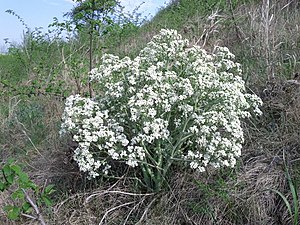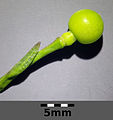Tatar sea cabbage
| Tatar sea cabbage | ||||||||||||
|---|---|---|---|---|---|---|---|---|---|---|---|---|

Tatar sea kale near Ottenthal in Lower Austria |
||||||||||||
| Systematics | ||||||||||||
|
||||||||||||
| Scientific name | ||||||||||||
| Crambe tataria | ||||||||||||
| Sebeók |
The Tatar sea kale ( Crambe tataria , also Tátorján sea kale or Tatar kale ) is a species of the cruciferous family (Brassicaceae). It naturally thrives in the South Siberian-Pontic-Pannonian flora region .
features
The Tatar sea kale grows as a perennial herbaceous plant that reaches a height of 60 to 90 cm. The very large, thick basal leaves are pinnately lobed, rhombic in outline and hairy on the underside. The flowers have four white petals.
In Austria, the species occurs in the colline altitude range on semi- arid grassland , road embankments and field edges above loess , the flowering period extends from April to May. The plant is a steppe roller : it breaks off at the base when it is ripe and is blown away by the wind. In this way the seeds can be spread over longer distances.
The number of chromosomes is 2n = 30.
photos
Natural occurrence in the Dunajovické Kopce nature reserve
Occurrence
The distribution area extends from the southern Ukrainian and southern Russian-Pontic steppe area north of the Black Sea to Lower Austria and South Moravia . The latter two cases are cold steppe relics from the last glacial , which occur spatially far away from the main distribution area in the east: During the ice age, the species spread to the west and could only survive in the postglacial there in isolated dry locations.
In Austria, the species occurs exclusively in the Zeiserlberg nature reserve near Ottenthal, with around 600 individuals, as well as sporadically in the surrounding area, and is considered endangered.
Common names
The other German-language trivial names Hieronymuswurz ( Moravia near Auspitz ), Tatarka (Moravia near Erlau), Tatarkenya (Moravia near Erlau) and Tatorya ( Transylvania ) exist or existed for the Tatar sea kale .
use
The Tatar wild cabbage was never cultivated, but probably already played a role as a wild vegetable in ancient times.
swell
- Manfred A. Fischer , Karl Oswald, Wolfgang Adler: Excursion flora for Austria, Liechtenstein and South Tyrol. 3rd, improved edition. State of Upper Austria, Biology Center of the Upper Austrian State Museums, Linz 2008, ISBN 978-3-85474-187-9 .
- Luise Schratt-Ehrendorfer: The flora of the steppes of Lower Austria: flora and vegetation, location diversity and endangerment. In: Heinz Wiesbauer (Hrsg.): The steppe is alive - rock steppes and dry grasslands in Lower Austria , St. Pölten 2008, p. 63, ISBN 3-901542-28-0
Web links
- Naturschutzbund NÖ: Nature reserve "Zeiserlberg" (PDF file, 604 KB)
- Datasheet for Tatar sea kale at Botanik in the picture - Flora of Austria , 2005.
- Distribution map for Europe
Individual evidence
- ^ Crambe tataria at Tropicos.org. In: IPCN Chromosome Reports . Missouri Botanical Garden, St. Louis
- ^ Georg August Pritzel , Carl Jessen : The German folk names of plants. New contribution to the German linguistic treasure. Philipp Cohen, Hannover 1882, p. 116. ( online ).
- ↑ B. Honermeier: Crambe. In: Klaus-Ulrich Heyland, Herbert Hanus, Ernst Robert Keller: Oil fruits, fiber plants, medicinal plants and special crops. Handbook of Plant Cultivation Volume 4, Eugen Ulmer KG, Stuttgart 2006, ISBN 978-3-8001-3203-4 , pages 179-184.







